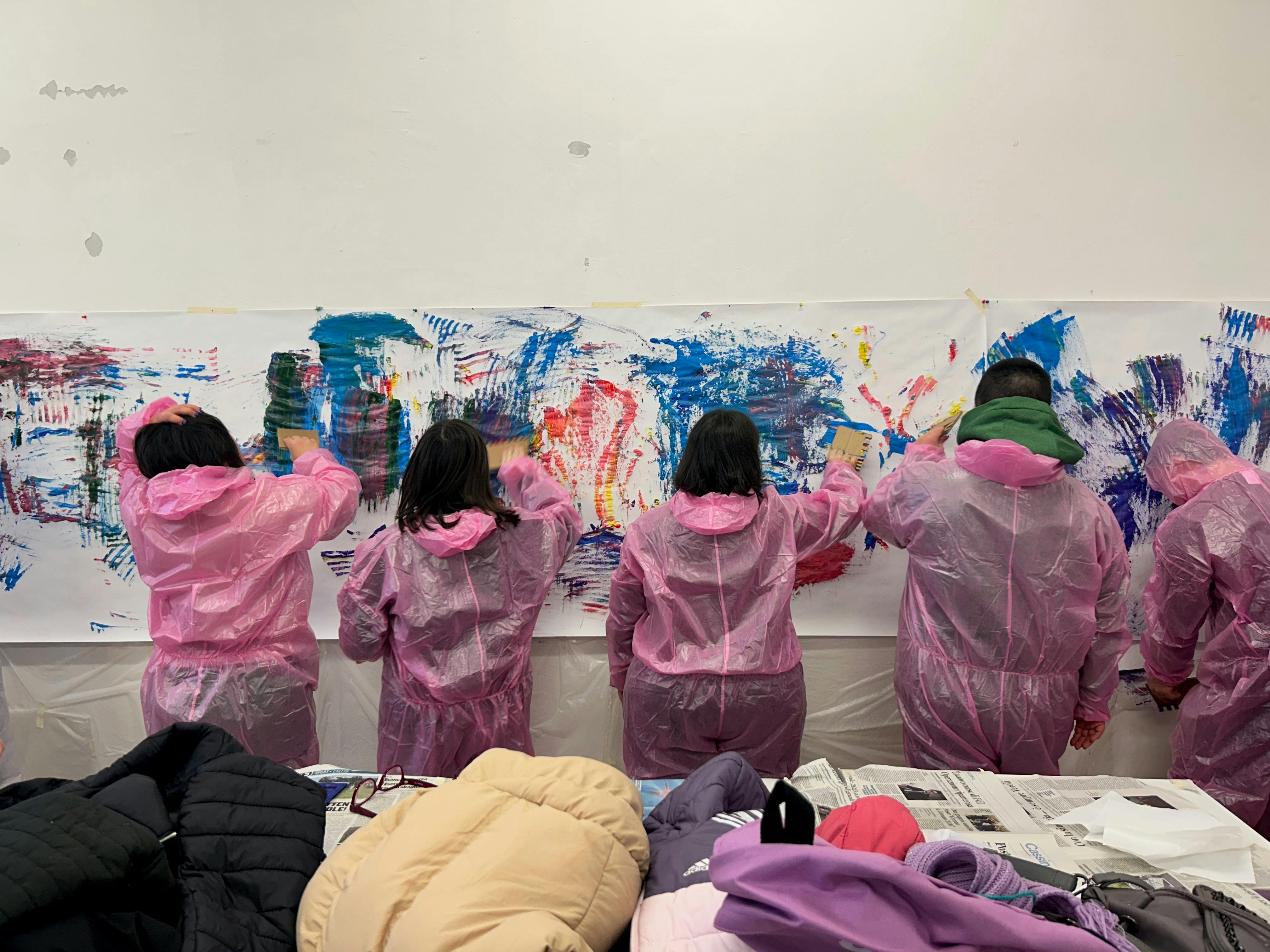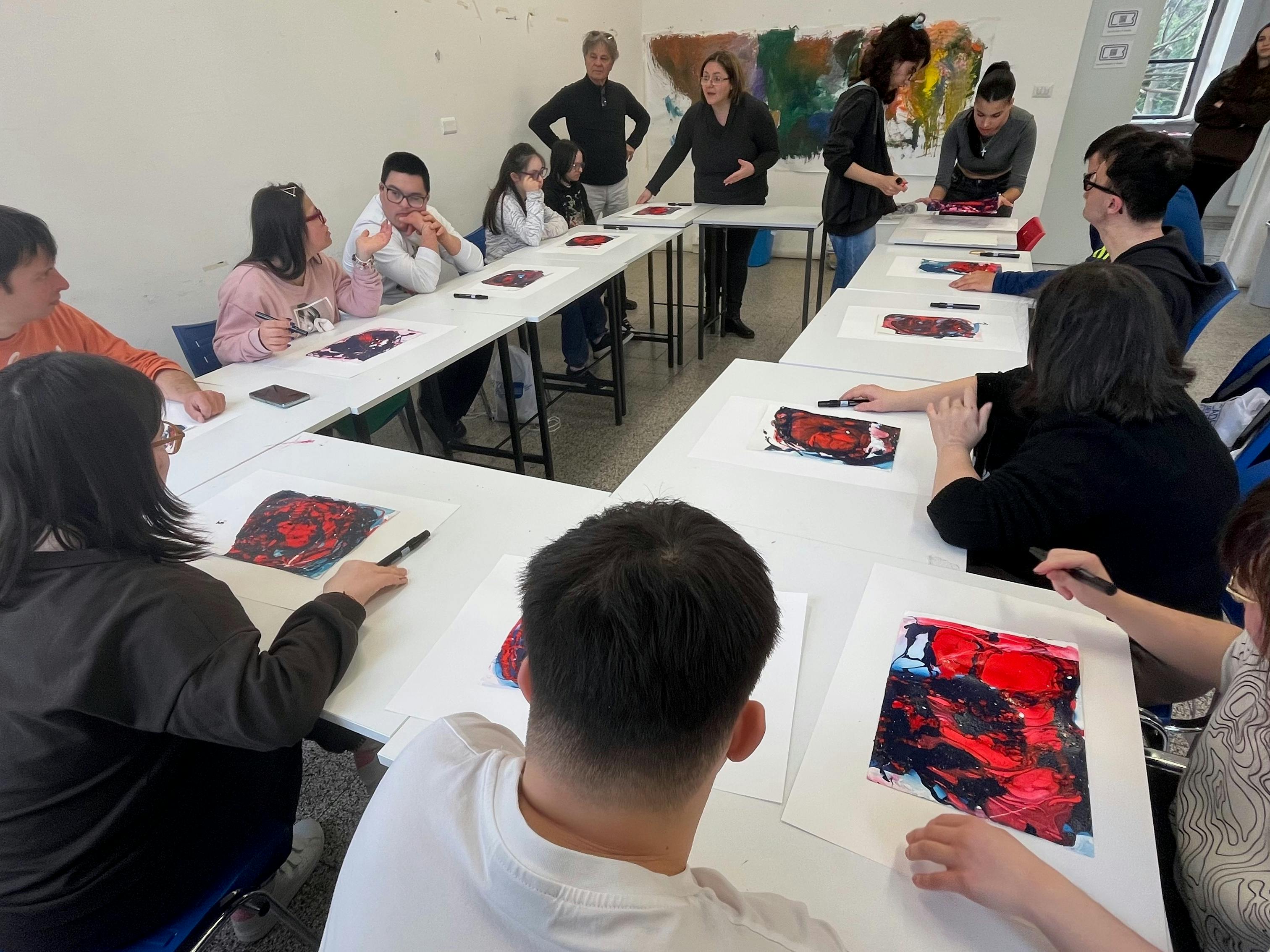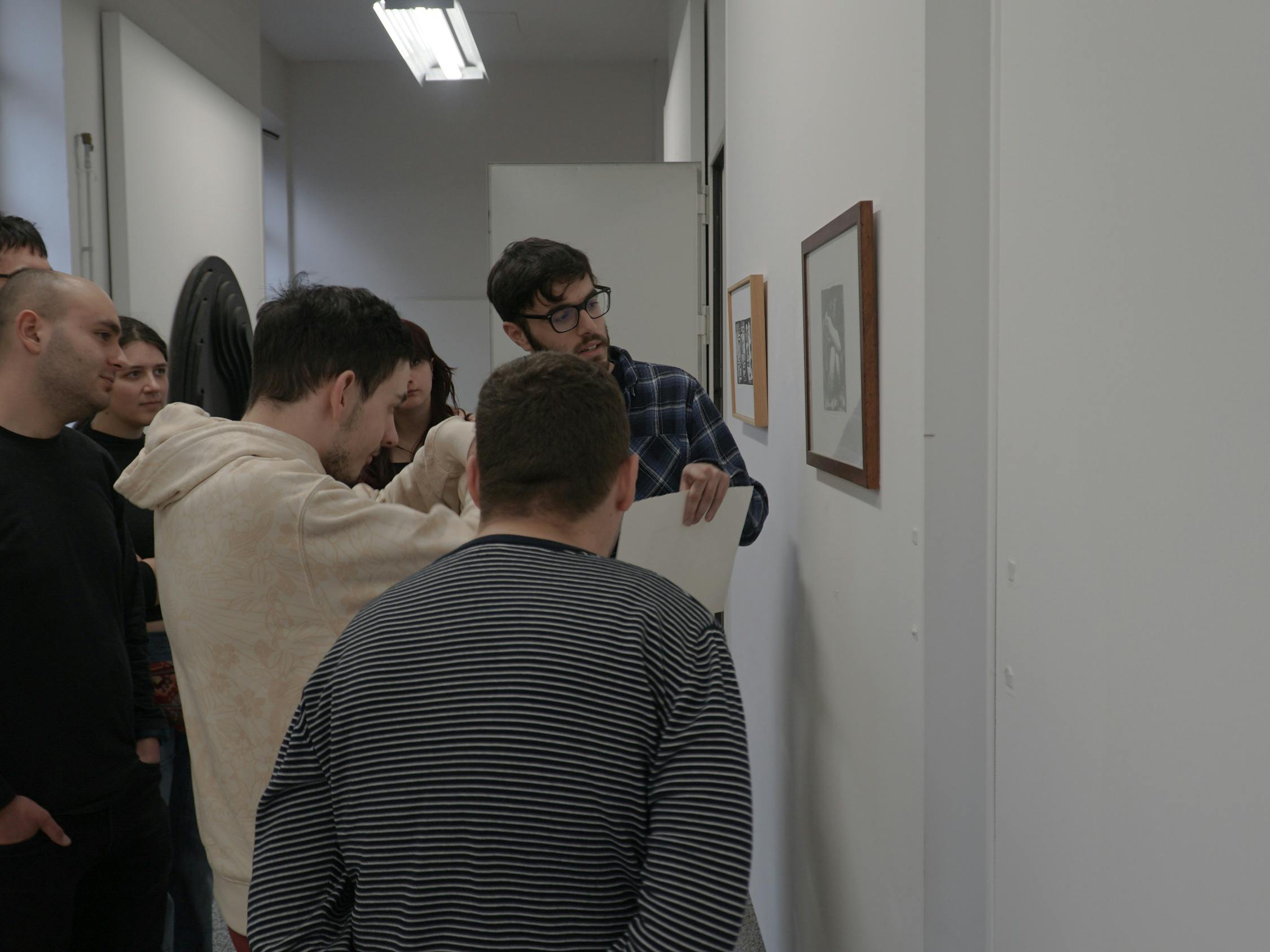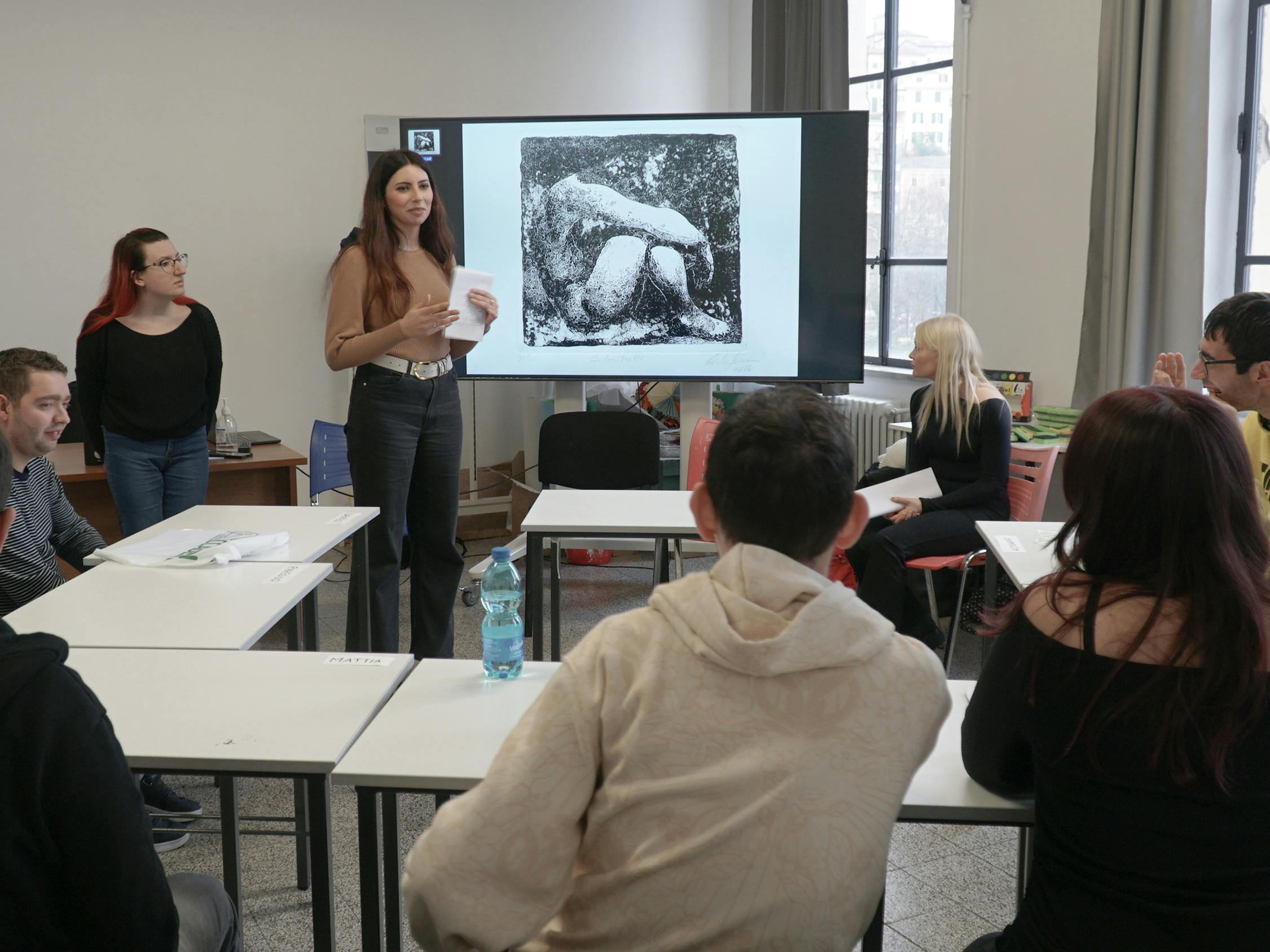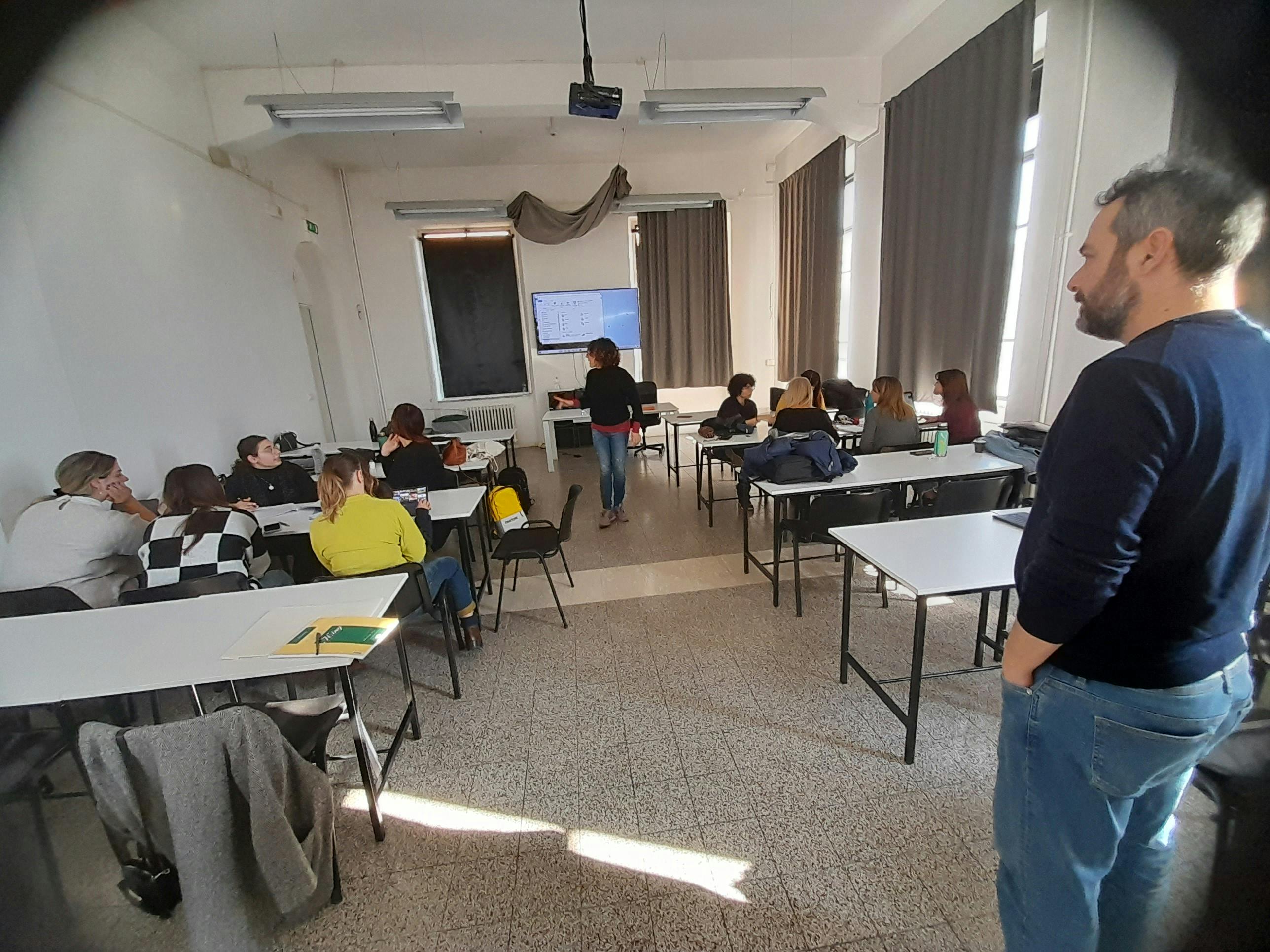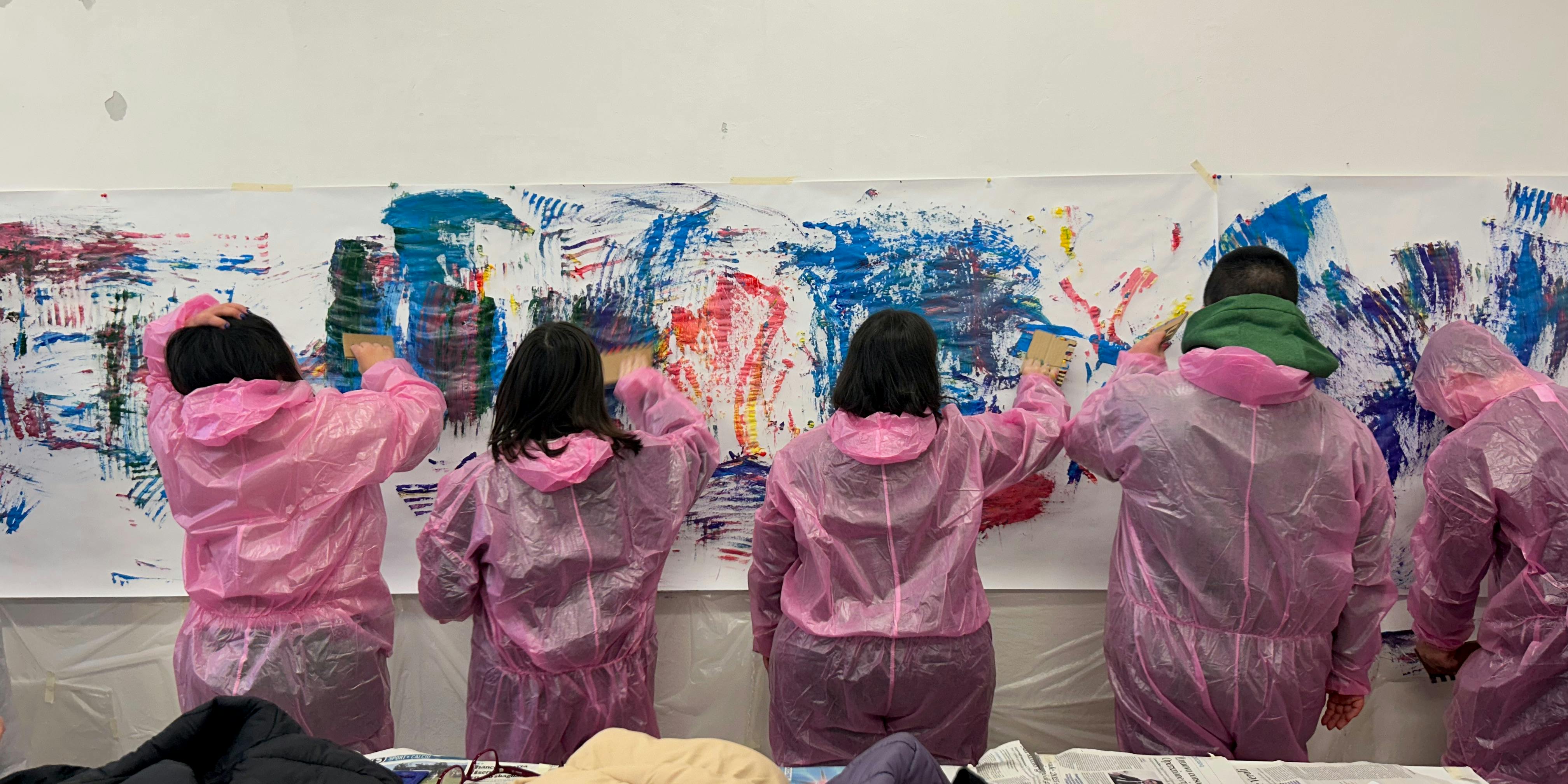
How does one train on accessibility?
The experience of the Accademia di Belle Arti di Frosinone
by Paolo Marabotto
In the last three years, the Accademia di Belle Arti di Frosinone, initially under the direction of prof. Loredana Rea and currently under the one of prof. Stefania di Marco, has heavily invested in creating training pathways on accessibility.
Since 2023, in fact, a collaboration with Museo Facile, an academic spin-off of the Università di Cassino e del Lazio meridionale directed by prof. Ivana Bruno, began, leading to several workshops on art and blindness, art and deafness, and art and storytelling aimed at co-producing, with students, devices to make some works accessible at the Museo di Arte Contemporanea (MACA) of the Accademia di Belle Arti di Frosinone. These devices will soon be available on the Academy's digital platform.
At the same time, prompted by requests from local organizations, particularly from AIPD of Frosinone, which works with young people with Down syndrome, and the Associazione Anche Noi, which works with young people within the autism spectrum disorder, we started working, during the classes of the course of Communication and Enhancement of Contemporary Artistic Heritage, on accessibility for people with cognitive disabilities.
This year the course also benefitted from the contribution of Dr. Ester Orglia, a PhD candidate in pedagogy and art didactics, who is working on the project Museum Accessibility for People with Down Syndrome: an investigation into the emotional, cognitive, and behavioral aspects of the artistic experience.
In our academy, there are no art therapy chairs, and this has encouraged us to try to understand what could be our specific contribution to student training and work with association youths.
The specificity of academic teaching, based on a theoretical-practical approach, led us to conceive a didactic plan aimed at training skills capable of designing and implementing experiential activities where ideas and emotions were processed through the hands, using languages and techniques learned over the years. The course was organized in an initial phase, in the first semester, consisting of study, research, learning methodologies and areas to focus on, and a subsequent one, in the second semester, dedicated to building and facilitating workshops, thus continuing training through experience and critical field verification.
We therefore organized the course in this way.
First phase
Learning to listen
Every teaching activity is built starting from listening:
- listening to the students through the analysis of a questionnaire aimed at understanding their educational paths, passions, skills, and abilities;
- listening to the Associations to understand needs, goals, and expectations and to avoid offering them standardized paths projected by stereotypes. Over the years, we have been asked to address themes such as: self-awareness, relationships with others, knowledge and management of anger.
Choosing the works to work on
Together, association operators (educators and psychologists) and students selected for each topic some works present at MACA. We always chose to start from physically experienceable works because direct enjoyment is already an experience in itself. The works had to evoke or provide cues of contiguity with the chosen theme.
In front of the works, students lingered extensively, filling out a personal questionnaire on which to note:
- emotions;
- physical sensations;
- evocations and associations;
- ideas related to the work.
At the time of completing the questionnaire, students partially knew or completely ignored who the author was and what the meaning of the work was.
This approach was functional to very freely receive those emotional and experiential flows that the work releases and that could become paths to share. Free flows, not conditioned by knowledge, and authentic because experienced firsthand, would make their testimony in workshops more credible.
Research and construction of a conceptual map
Then came the study of the work and the artist, making an effort to organize information by themes, concepts, and styles. From here a first conceptual map was built and implemented in small group work throughbrainstorming in which the most disparate images, observations, procedures, games, activities, stories, and quotes were freely associated with the found concepts.
Defining the structure of the workshops
From this map, a starting point was chosen and linked to the others. Then hypotheses of sequences of activities, reflections, images, narratives, etc. were built, and constituted the skeleton of the workshop.
This had a simple structure that could be repeated several times: the launch moment or engagement phase; a manual activity; a conclusion, that is, a moment of elaboration seeking to extract images and words from the experience to metabolize it.
Areas to focus on
In building the workshop attention was paid to:
- timing, activity duration, and the users’ attention curve: this helped us choose the most suitable moments to launch themes, peaks, and releases, program alternating techniques, figures, tones, postures, and spaces, etc.;
- language, by means of a sustainable one for the interlocutors, which would not trivialize or give up the complexity of the topics; reformulate concepts and processes multiple times, using images, analogies, manipulations, and examples to avoid proposing them in their abstract form; write a kind of script to tune in to the users’ frequencies; address complexity by sequencing it into simple steps, relying on metaphors and analogies; create illustrated stories and short cartoons;
- space, to increase the awareness that spatial relationships communicate, and therefore to pay attention to different arrangements during activities; to organize spaces diversifying them by function; to territorialize and ritualize space;
- play and irony: «Everything with play, nothing for play», said Baden Powell. We framed all the activities in a playful atmosphere: a joyful, cheerful, ironic, light, non-judgmental environment;
- manual skills and images. Every concept intended to be communicated had to be processed through manual activities, not to remain a theoretical statement but to achieve concreteness, a spherical quality that could be visited and traversed and thus filled with personal meaning. For each concept, multiple linguistic registers were sought to communicate it. We reflected on and practiced how much and how thought can be built through images and manipulations.
Second phase
Sheets
Before the workshops, some very simple sheets about the work and the artist were sent to the associations to introduce: the artist, the work, its meaning, and other works developing the same theme.
Workshops
On the day of the workshop, the youths found a backpack and a binder to keep the materials produced and points for further exploration, possibly at the association or at home.
We thus went in front of the work and, after a brief explanation/interaction/engagement, returned to the classroom where, more comfortably seated, projecting the work again onto the interactive whiteboard, a discussion would start. After a break for snacks, needed also to set more spontanueous, individual chats with the youths, the activities would start again. In workshops with youths with Down syndrome, prof. Carlo Delli Colli led activities of body movement, during which the workshop themes were transposed into individual and group movements.
The workshop was ending sharing and giving feedbacks, animated by association operators, and completing a brief individual questionnaire.
Student training lasted the whole year, and the meetings with the youths of the different associations were 5 per year, from February to May. The year ended with a party and an exhibition at the Academy, open to all, during which videos were projected and diplomas distributed.
This year, the Academy students and the association youths ran two workshops for schools about the same themes they addressed during their own laboratories. They divided the tasks according to their possibilities: some explained, some helped distribute materials, others assisted students in the various phases. It was a very engaging and extraordinarily meaningful experience for the growth of everyone’s self-esteem.
Final considerations
I believe that on the theme of accessibility, both in terms of training and reception, Academies can play a specific role for several reasons.
All the Academy programs indeed train students to become capable of creating, innovating, and experimenting with artistic languages that continuously expand the front of communication, enabling connection with diverse sensitivities.
This approach makes the way of building accessibility unique because, while discovering different registers to connect with cognitive disability, this effectively becomes a new path accessible to all to reach the experience of art.
The search for new registers enormously broadens the threshold of accessibility to art for everyone.
The title we gave to the workshop with youths with autism spectrum disorder was Gulliver’s Travels, which, on a closer inspection, are actually shipwrecks! And what is it that must be wrecked, if not customs, common sense, and a stereotyped or overly rational and controlled mode to approach art, which prevents us from understanding it and reaching the stage of meaning it can have for each of us?
Training in accessibility means rethinking the paths of exploration and discovery of art, tuning into users’ responses, and allowing oneself to be carried into unexplored universes. It is a necessary experience for acquiring a different point of view, perhaps a vision, for everyone.
This contribution of mine reflects a long path of awareness matured at various moments and contexts thanks to many encounters: Giuseppina Digrandi (Accessibility project Manager and Art Psychology professor, Accademia di Belle Arti di Frosinone); Loredana Rea (Art historian and MACA manager, Accademia di Belle Arti di Frosinone); Carlo Delli Colli (Computer graphics professor, Accademia di Belle Arti di Frosinone); Donella Di Marzio (Art Pedagogy professor, Accademia di Belle Arti di Napoli); Ivana Bruno (Museology and Art Criticism professor, UNICAS/Museo Facile); Piero Lucisano (Experimental Pedagogy emeritus professor, La Sapienza. Università di Rome); Martina De Luca (former Education Manager, GNAM Rome, Training Manager and Course Curator, Scuola nazionale del patrimonio e delle attività culturali); Caterina Bolasco (art historian, animator, and illustrator); Pietro Vecchiarelli (head of the Tactile Books section of the Federazione Nazionale delle Istituzioni pro Ciechi); Francesca Colonnelli (head of the Associazione Cornelia); Ester Origlia (PhD candidate UNICAS-Accademia di Belle Arti di Frosinone); Valentina Pacifici (filmmaker); AIPD, Frosinone; Associazione "Anche Noi", Frosinone; Associazione "Le Torri", Roma; Claudia Tanga (psychologist).
